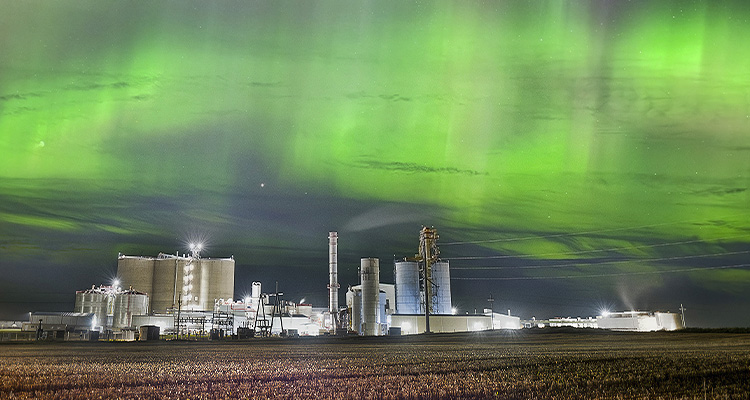Take a deep dive into Red Trail Energy’s bioethanol manufacturing process
Founded in 2003, Red Trail Energy LLC (RTE) is a North Dakota-based investor group. “We are focused on financing, constructing, and, since 2007, operating a 50-million-gallon name-plate capacity corn-based bioethanol production facility near Richardton, North Dakota,” opens Jodi Johnson, CEO of RTE. “RTE is 100 percent investor-owned and governed by a board of directors encompassing seven members,” she adds.
Jodi explains in greater detail what RTE’s production footprint looks like. “Each year, RTE produces 65 million gallons of bioethanol, utilizing 23 million bushels of corn. In simpler terms, one bushel of corn enables us to generate 2.85 gallons of bioethanol. This bioethanol serves as a sustainable fuel in the transportation sector. Additionally, we specialize in manufacturing coproducts. Per year, this includes 125,000 tons of dried distillers grains, 80,000 tons of modified distillers grains, 25,000 tons of syrup, all of which are sold as animal feed, and 20 million pounds of distillers corn oil, which acts as a feedstock for second generation biofuel,” she enlightens.
To support the production of its bioethanol, RTE operates a state-of-the-art plant in North Dakota, which Jodi tells us all about. “Originally established as a coal-fired facility, our plant was converted to run on natural gas in 2016. With investments exceeding $60 million, RTE’s North Dakota plant has witnessed significant upgrades and expansions throughout its existence. As a result, it now produces 65 million gallons of bioethanol per year. Some of the other investments we made include the installation of a railroad track for enhanced shipping capabilities, expanding the production process to increase output, and implementing a corn oil extraction system to create more coproducts. Notably, RTE acquired a United States pharmacopeia (USP) distillation setup, allowing it to produce higher-purity USP alcohol that meets the USP monograph, thereby broadening our product offerings. Lastly, a carbon capture and storage unit was added, reducing the carbon intensity of our bioethanol,” she recounts.
Within this plant, RTE has implemented various technologies to make its corn-based products manufacturing more efficient. “Received as a raw commodity, our corn initially passes through hammermills, which grind it into a fine granular consistency known as corn meal. From there, the meal is transported via a conveyor to the processing building, where it is mixed with water and enzymes, and heated to 186 degrees Fahrenheit, breaking the starch down into fermentable sugars. To lower its temperature to 92 degrees Fahrenheit, the mixture is then passed through a series of heat exchangers. Next, yeast is added to the mixture, which is then transferred to one of our four fermentation tanks. Within these tanks, biological fermentation takes place, converting the starches into sugars and subsequently into alcohol. As the yeast begins to ferment, the reaction produces heat, CO2, and alcohol. After approximately 60 hours, the mixture transforms into beer, containing around 15 percent alcohol. 
“The beer is then pumped from the fermentation tanks into a three-column distillation process, encompassing the beer column, rectifier, and side stripper, separating the alcohol from the water and solids. The resulting product is further heated and sent through molecular sieves to remove any remaining water, yielding our final 200-proof alcohol product. Upon receiving certification from our lab, the 200-proof alcohol is blended with a denaturant and stored ahead of shipment,” Jodi informs.
This meticulous process has enabled the creation of RTE’s top-quality products for many years, leading the company to secure diverse projects. “Besides our innovative carbon capture and storage (CCS) project and becoming the first ethanol plant to participate in the voluntary carbon market, RTE is planning to begin selling cellulosic ethanol this year. In 2023, we introduced a trial and certification process for corn kernel fiber (CKF) enzymes. Cellulosic feedstocks, such as CKF, are derived from non-food-based materials and composed of cellulose, hemicellulose, and lignin. These abundant feedstocks are essential to the production of biofuels. Notably, cellulosic ethanol stands out for its sustainability as it utilizes non-food feedstocks and possesses a low carbon footprint.”
Recognized for its economic and environmental impact in North Dakota, RTE places great emphasis on supporting its community. Jodi sheds light on what this commitment entails. “At RTE, we believe in the importance of supporting our community the same way it supports us. As a 100 percent investor-owned company, with 80 percent of our investors residing in North Dakota, we prioritize local investment to underscore our commitment to the region’s agriculture and economy. To uphold this commitment, we follow two key practices. Firstly, we utilize locally produced corn as feedstock for ethanol production. Historically, we directly purchase 95 percent of our corn from local producers, except during drought or low-acre years when it amounts to 75-to-80 percent. Approximately 60 percent of these corn purchases originate from within a 100-mile radius of our plant in Richardton. Each day, around 80-to-100 trucks deliver corn to our facility. Secondly, we are strongly focused on encouraging a safe and healthy work environment by participating in joint training and response exercises with local emergency personnel. This fosters strong relationships and familiarity with our facility and employees. Our dedication to supporting local farmers and businesses is fundamental to our operations, reflecting our commitment to economic and environmental sustainability in North Dakota,” Jodi states.
Looking ahead, RTE is poised for further sustainable innovation and community partnership.
